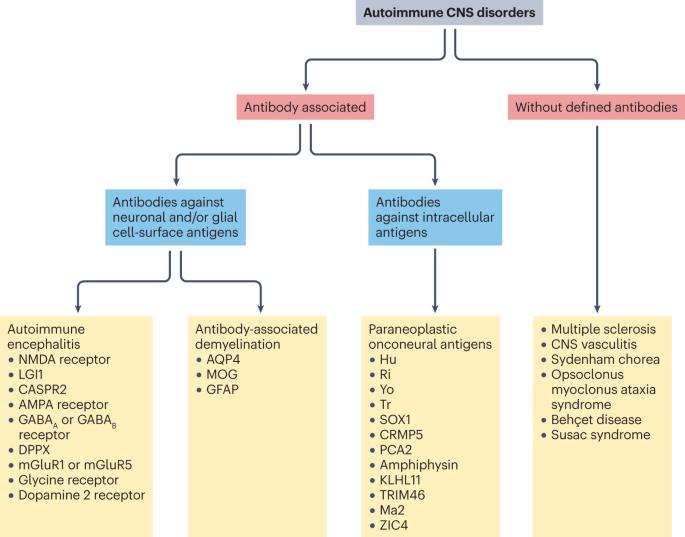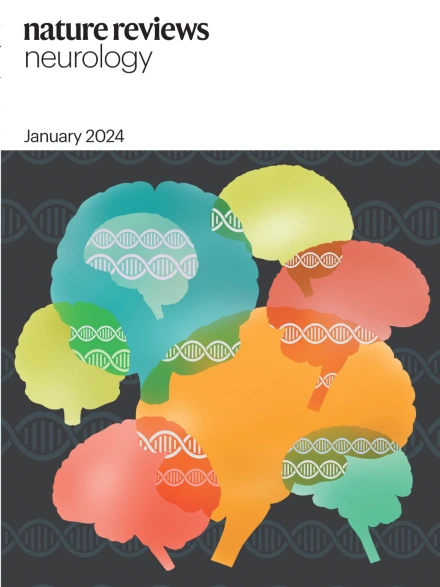Origins and immunopathogenesis of autoimmune central nervous system disorders
IF 33.1
1区 医学
Q1 CLINICAL NEUROLOGY
引用次数: 7
Abstract
The field of autoimmune neurology is rapidly evolving, and recent discoveries have advanced our understanding of disease aetiologies. In this article, we review the key pathogenic mechanisms underlying the development of CNS autoimmunity. First, we review non-modifiable risk factors, such as age, sex and ethnicity, as well as genetic factors such as monogenic variants, common variants in vulnerability genes and emerging HLA associations. Second, we highlight how interactions between environmental factors and epigenetics can modify disease onset and severity. Third, we review possible disease mechanisms underlying triggers that are associated with the loss of immune tolerance with consequent recognition of self-antigens; these triggers include infections, tumours and immune-checkpoint inhibitor therapies. Fourth, we outline how advances in our understanding of the anatomy of lymphatic drainage and neuroimmune interfaces are challenging long-held notions of CNS immune privilege, with direct relevance to CNS autoimmunity, and how disruption of B cell and T cell tolerance and the passage of immune cells between the peripheral and intrathecal compartments have key roles in initiating disease activity. Last, we consider novel therapeutic approaches based on our knowledge of the immunopathogenesis of autoimmune CNS disorders. This article reviews key pathogenic mechanisms underlying the development of CNS autoimmunity, focusing on the role of autoantibodies that target neuronal and/or glial cell-surface antigens. The authors consider novel therapeutic approaches based on knowledge of the immunopathogenesis of autoimmune CNS disorders.

自身免疫性中枢神经系统疾病的起源和免疫发病机制
自身免疫性神经病学领域发展迅速,最近的发现加深了我们对疾病病因的理解。本文回顾了中枢神经系统自身免疫发病的主要致病机制。首先,我们回顾了年龄、性别和种族等不可改变的风险因素,以及单基因变异、易感基因中的常见变异和新出现的 HLA 关联等遗传因素。其次,我们强调环境因素和表观遗传学之间的相互作用如何改变疾病的发病和严重程度。第三,我们回顾了与免疫耐受丧失有关的诱发因素可能导致的疾病机制,这些诱发因素包括感染、肿瘤和免疫检查点抑制剂疗法。第四,我们概述了对淋巴引流和神经免疫界面解剖学认识的进步如何挑战了长期以来中枢神经系统免疫特权的观念,这与中枢神经系统自身免疫直接相关,以及 B 细胞和 T 细胞耐受性的破坏和免疫细胞在外周和鞘内之间的通过如何在疾病活动的起始阶段发挥关键作用。最后,我们将根据对自身免疫性中枢神经系统疾病免疫发病机制的了解,探讨新的治疗方法。本文回顾了中枢神经系统自身免疫发病的关键致病机制,重点讨论了针对神经元和/或胶质细胞表面抗原的自身抗体的作用。作者基于对自身免疫性中枢神经系统疾病免疫发病机制的了解,探讨了新的治疗方法。
本文章由计算机程序翻译,如有差异,请以英文原文为准。
求助全文
约1分钟内获得全文
求助全文
来源期刊

Nature Reviews Neurology
医学-临床神经学
CiteScore
29.90
自引率
0.80%
发文量
138
审稿时长
6-12 weeks
期刊介绍:
Nature Reviews Neurology aims to be the premier source of reviews and commentaries for the scientific and clinical communities we serve. We want to provide an unparalleled service to authors, referees, and readers, and we work hard to maximize the usefulness and impact of each article. The journal publishes Research Highlights, Comments, News & Views, Reviews, Consensus Statements, and Perspectives relevant to researchers and clinicians working in the field of neurology. Our broad scope ensures that the work we publish reaches the widest possible audience. Our articles are authoritative, accessible, and enhanced with clearly understandable figures, tables, and other display items. This page gives more detail about the aims and scope of the journal.
 求助内容:
求助内容: 应助结果提醒方式:
应助结果提醒方式:


